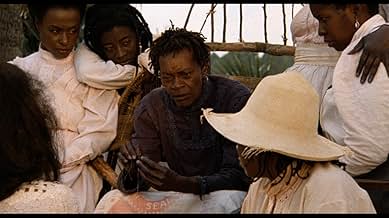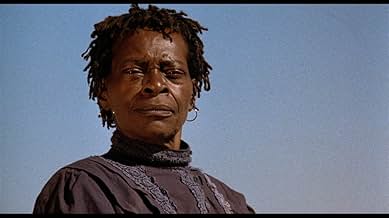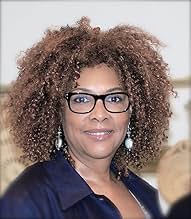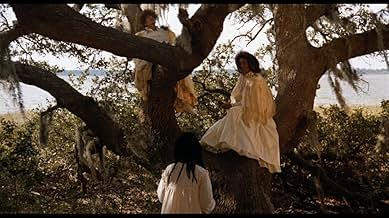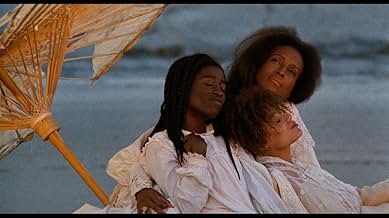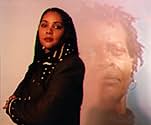IMDb RATING
6.6/10
3.6K
YOUR RATING
A languid, impressionistic story of three generations of Gullah women living on the South Carolina Sea Islands in 1902.A languid, impressionistic story of three generations of Gullah women living on the South Carolina Sea Islands in 1902.A languid, impressionistic story of three generations of Gullah women living on the South Carolina Sea Islands in 1902.
- Awards
- 4 wins & 2 nominations total
Barbara O
- Yellow Mary
- (as Barbara-O)
Tony King
- Newlywed Man
- (as Malik Farrakhan)
- Director
- Writer
- All cast & crew
- Production, box office & more at IMDbPro
Featured reviews
It's tough to sort my feelings on Daughters of the Dust. The film is built around a compelling and often forgotten segment of black history that maintains social resonance beyond its time and place; director Julie Dash deserves credit for capturing the emotion and pain of cultural transformation, and there are lovely images throughout. But Daughters of the Dust makes very little effort to engage the audience: it's difficult to maintain a sense of each character's individual goals, and the film often sacrifices narrative momentum for visual poetry. Unfortunately, I'm left with a film that interests me more in theory than in practice. -TK 9/30/10
"Daughters of the Dust" isn't an easy work, but it's a very fine accomplishment, and one of the most important African American films of the last 20 years.
Julie Dash has chosen to share with her audience a chapter of black history that is still new to most white Americans, the internal issues that came with Black Americans as they made their way North in the years between 1900 and 1920. The separation from the soil, the divorce from those remnants of West African culture that survived through the holocaust of slavery. The psychic tearing of the transition from rural to urban culture. The skin game that Yellow Mary and other "fair skinned" Black people had to play in order to survive in White America. If the film is boring to many, let it be plainly said that it is boring for many because the film maker courageously chose to examine a piece of history that most White Americans- and many Black ones- no longer care much about.
If you want to be entertained, this isn't a film you'll enjoy. "Daughters of the Dust" offers instead an opportunity to probe deep, to look close at the dreamy quality of an internal life, and a balanced relationship with the earth, that most of our peoples in the United States have chosen to leave behind them for exactly the wrong reasons. Let those who have difficulty thinking about these things stick to action films. "Daughters of the Dust" is about something more akin to the sense of wonder that's being rapidly stamped out of many of us in the name of mom, apple pie, and the gross national product. It is worth not one, but many viewings. Julie Dash has created a masterpiece of American cinema.
Julie Dash has chosen to share with her audience a chapter of black history that is still new to most white Americans, the internal issues that came with Black Americans as they made their way North in the years between 1900 and 1920. The separation from the soil, the divorce from those remnants of West African culture that survived through the holocaust of slavery. The psychic tearing of the transition from rural to urban culture. The skin game that Yellow Mary and other "fair skinned" Black people had to play in order to survive in White America. If the film is boring to many, let it be plainly said that it is boring for many because the film maker courageously chose to examine a piece of history that most White Americans- and many Black ones- no longer care much about.
If you want to be entertained, this isn't a film you'll enjoy. "Daughters of the Dust" offers instead an opportunity to probe deep, to look close at the dreamy quality of an internal life, and a balanced relationship with the earth, that most of our peoples in the United States have chosen to leave behind them for exactly the wrong reasons. Let those who have difficulty thinking about these things stick to action films. "Daughters of the Dust" is about something more akin to the sense of wonder that's being rapidly stamped out of many of us in the name of mom, apple pie, and the gross national product. It is worth not one, but many viewings. Julie Dash has created a masterpiece of American cinema.
Julie Dash grew up in Long Island, New York and graduated from CCNY right after high school with a degree in film production. Dash moved to L.A. only to be rejected by UCLA's film department, but later accepted as a student of the American Film Institute through a fellowship. Grants then started rolling in and Dash was able to begin writing and shooting films which revolved around true historical portrayals and images of African woman such as depicted in Daughters of the Dust. This film was written, directed and then released by Julie Dash in 1991. The historical context of this film stretches from the time of the slave trade up to the summer of 1902, when the Peazant family left an island off the coast of South Carolina and headed north for the mainland. I would consider this film to be within the genre of modern melodrama because of the overly emotional acting styles, complex plot, long monologues and excellent musical score which seems to parallel the moods in each scene perfectly. I also found the mis en scene, as far as the setting, costume, figure movement and expression and cinematography to be very well done. This is an intense film definitely worth watching.
Daughters of the Dust is film that slits the eyes of spectators who have been fed only linear and simplistic narrative/plot dev'ts through hollywoodism and can't possibly fathom any other way of being/thinking. It is truly an excruciating film to watch for those who have not dreamt and lived the "double consciousness" of modernity, for those who do NOT want to recall and remember the fact of american quilombos, maroon societies, slave revolters and runaways who succesfully established another way of life, not based on european dominance. This story is about the struggles of maintaining that community in 1902, a turning point in the life of this one maroon society. Dash breaks with cinematic codes in her experimental reconstruction of historical memory...a forgotten episode in African american history, a forgotten place, re-calling back to life ancestors that had survived and thrived: The Gullahs, Peazant family, persisting, unerasable, as the unborn child running through our memory, coming out of our past, forging a new and alternative future: a future that rejects the limitations of western epistemology. The summoning of these images to screen from the unwritten (african) past provides its own logic and development which Dash successfully visualizes in a polyphonic tradition, many voices, multiple perspectives. She does not allow a simplistic and individualistic rendering of this history...NO!she allows the struggle of divergent african perspectives, Christian, Muslim, Africanist, Native American to emerge in the same frame, to address that age old question: To exist or not to exist, to bear witness or to forget. In order for this history to exist and bear witness, Julie Dash does not allow any conventional reductionary scheme of narrativity, her temporal references are not linear. Her story is told through palimpestic time, the past present and future, overlapping and disjunctive: rupturing our understanding of history/memory and identity. The conflict that drives the film's narrative is not individual ego/conventional good vs bad drama/or boy gets girl(Hollywoodism); the conflict is how will the communal memory of these African survivors be salvaged from the ravaging of modernism's erasure..We see the family eat their last supper as the rite of passage to a life on the other side, a side that the ancestors fought to diverge from...The film is testimony to the african ancestors and to the spirit of resistance of slave revolters. Many people have offered criticism of dash's "feminism." Feminism is a problematic concept to apply to this film, no it is not feminist, it is afro-centric, matri-focal, and woman, as bearer of culture and memory as mother to the community, becomes the embodiment of that struggle. (of course it is not "feminist": it doesn't speak about abortion law, equal pay, etc etc..this kind of feminism is eurocentric and simplistic..) Thank you Julie Dash, i am not african american but the tears poured down my face as i, too, recalled that life left behind, another time another place. A place where people, muslims/christians/indigenous or any other can actually co-exist peacefully side by side, respectful of each other's differences. The character who chose to leave her so called "civilized" mother at the last minute, to take off with her Native American lover..is one of the most powerful onscreen testimony of love between indigenous peoples that has ever been made.
Daughters of The Dust was produced by Geechee Girls and American Playhouse Company. The movie main focus is on the Peazant women. Nana Peazant is played by Cora Lee Day, and Eula, her granddaughter, is played by Alva Rogers who is pregnant and has been raped by a landowner. Nana's granddaughter, Yellow Mary, is played by Barbara-O who is returning, with her friend Trula, from the mainland and her life as a prostitute and wet nurse. Haggar, who has married into the family, is played by Kaycee Moore and wants nothing to do with the old traditions. Similarly, the Christian Viola, played by Cheryl Lynn Bruce, is returning from her life on the mainland.
Daughters of the Dust is a film written and directed by Julie Dash. It tells the story of a family of African-Americans who have lived for many years on a Southern offshore island, and of how they come together one day in 1902 to celebrate their ancestors before some of them leave for the North. The film is narrated by an unborn child, and ancestors already dead also seem to be as present as the living.
Julie Dash underwent many hardships in bringing the story to the silver screen. She had severe budget constraints, filmed in mosquito and insect infested areas, was delayed by Hurricane Hugo, sidetracked by sudden and violent sandstorms, and was forced to decide to either have a child or make the movie. In the end, she choose to give birth and nurture the story Daugthers of the Dust and the result is an unconventional masterpiece.
Initially, the response by white male critics was not favorable and they accused Dash of not adequately explaining the Gullah people, their culture, and their religious traditions. While attacking Dash, these critics failed to acknowledge many positive aspects of the film. The reasons behind this, according to Bell Hooks, is that "we've never been taught, most of us, in any history class that black people had different languages, had different religious practices, etc. So, to some extent, the film represents that challenge to a critic of any race" to review something they are not familiar with.
Because of these reviews and the fact that movie tells the story of African American women in an unconventional manner, it would seem to have slim commercial prospects. However, through word of mouth and some positive reviews it was able to generate a cult following. To date, the film has grossed 1.6 million from a budget of only 800,000.
The Newark Black Film Festival has chosen Daughters as the Film of The Century while the British Film Institute's Sight and Sound Magazine chose the soundtrack as one of the best in the past 25 years. It also received the Best Cinematography award at the Sundance Film Festival in 1991.
I believe the film hits the viewer on various levels. By placing the story in the early 1900's, Dash is able to show us a turbulent time for African-Americans and address many issues such as migration, lynching, and the changing African-American culture. Dash also shows and teaches us about Ibo culture and it's importance in the lives of those inhabiting the Sea Coast Islands, not just the African-Americans sharing the Gullah culture, but also the Native Americans, Muslims, and Christians.
Daughters of the Dust is a film written and directed by Julie Dash. It tells the story of a family of African-Americans who have lived for many years on a Southern offshore island, and of how they come together one day in 1902 to celebrate their ancestors before some of them leave for the North. The film is narrated by an unborn child, and ancestors already dead also seem to be as present as the living.
Julie Dash underwent many hardships in bringing the story to the silver screen. She had severe budget constraints, filmed in mosquito and insect infested areas, was delayed by Hurricane Hugo, sidetracked by sudden and violent sandstorms, and was forced to decide to either have a child or make the movie. In the end, she choose to give birth and nurture the story Daugthers of the Dust and the result is an unconventional masterpiece.
Initially, the response by white male critics was not favorable and they accused Dash of not adequately explaining the Gullah people, their culture, and their religious traditions. While attacking Dash, these critics failed to acknowledge many positive aspects of the film. The reasons behind this, according to Bell Hooks, is that "we've never been taught, most of us, in any history class that black people had different languages, had different religious practices, etc. So, to some extent, the film represents that challenge to a critic of any race" to review something they are not familiar with.
Because of these reviews and the fact that movie tells the story of African American women in an unconventional manner, it would seem to have slim commercial prospects. However, through word of mouth and some positive reviews it was able to generate a cult following. To date, the film has grossed 1.6 million from a budget of only 800,000.
The Newark Black Film Festival has chosen Daughters as the Film of The Century while the British Film Institute's Sight and Sound Magazine chose the soundtrack as one of the best in the past 25 years. It also received the Best Cinematography award at the Sundance Film Festival in 1991.
I believe the film hits the viewer on various levels. By placing the story in the early 1900's, Dash is able to show us a turbulent time for African-Americans and address many issues such as migration, lynching, and the changing African-American culture. Dash also shows and teaches us about Ibo culture and it's importance in the lives of those inhabiting the Sea Coast Islands, not just the African-Americans sharing the Gullah culture, but also the Native Americans, Muslims, and Christians.
Did you know
- TriviaSelected to the Library of Congress National Registry of Film in 2004.
- Quotes
[first lines]
Nana Peazant: I am the first and the last. I am the honored one and the scorned one. I am the whore and the holy one. I am the wife and the virgin. I am the barren one and many are my daughters. I am the silence that you can not understand. I am the utterance of my name.
- How long is Daughters of the Dust?Powered by Alexa
Details
Box office
- Gross US & Canada
- $1,683,422
- Opening weekend US & Canada
- $10,842
- Nov 20, 2016
- Gross worldwide
- $1,689,776
- Runtime1 hour 53 minutes
- Color
- Aspect ratio
- 1.85 : 1
Contribute to this page
Suggest an edit or add missing content






